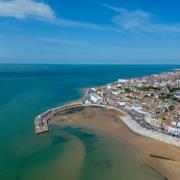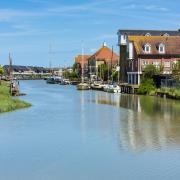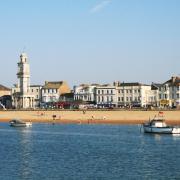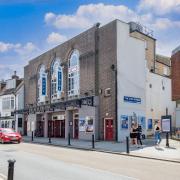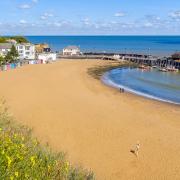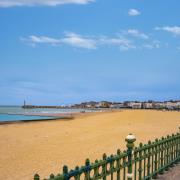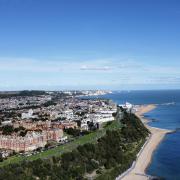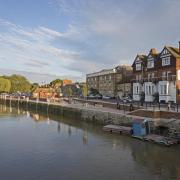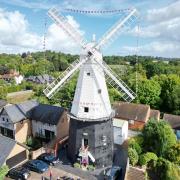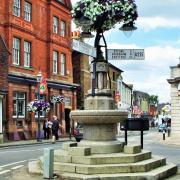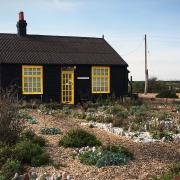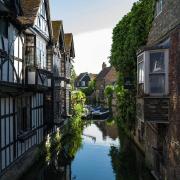One of the county's best-kept secrets, Dartford has fantastic travel links, one of Europe's finest shopping centres – and it's even got its own beach...
Alan Beckham
Alan is the general manager of Mitchell’s Carpets (01322 229018), which has been trading in Dartford since 1972. A recent facelift to the front of the premises has taken its appearance back to what it was in 1890, in accordance with the town centre’s Conservation Area status. “Dartford has been hit hard over the last few years by the recession, and the council has done great things on the outskirts of town,” says Alan. “I’m hoping we’ll get help with the town centre, because it really does need some support. We’ve got a complete mix of customers, ranging from those who live in council houses to people who live in manor houses.”
Tony Rudd
Tony is one of the owners of Reed Rains estate agents (01322 224436), who’ve been trading from the same premises for 30 years. Tony has been there for 13 years, and is upbeat about Dartford’s future. “The property market is looking good right now, and as long as people price their property correctly, it should sell quickly, because there’s a shortage of houses and there’s a lot of interest in buy-to-let investment, which makes good sense at present,” he says. “We’d like to see the town centre get a facelift, because I really think that would unlock Dartford’s tremendous potential. Our biggest qualm is the parking situation: I think it should be free, or just a minimal charge. What I like about Dartford is the town’s terrific transport facilities – you can get a train to central London inside half an hour and to the seaside towns just as easily.”
Considering a move?
There are excellent transport links, with Ebbsfleet station only 17 minutes from central London and the M25 on your doorstep. Several good schools nearby and house prices are reasonable, with one- and two-bedroom flats at around �108,000 and �141,000 respectively and a three-bedroom semi at about �219,000, with a four-bedroom detached house in the region of �377,000.
Dartford is on the northern border of Kent, just outside Greater London. The A2 links the town to south-east London; central London is approx 12 miles away. Close to M25, and the Dartford Crossing leads under/over the Thames to Essex. Trains from Dartford station reach central London in 30 minutes and Ebbsfleet International is about four miles away along the A2 and has high-speed rail links to London and Europe.
Satnav postcode: DA1 1DE
My Town
Jeremy Kite, leader of Dartford Council
Tell us about Dartford
We’re moving from being part of the old industrial part of Kent and developing into a new high-tech, slightly different sort of community. My job is to ease that transition and to try to be a council that has a good conversation with residents.
Advice to newcomers?
Put aside your preconceptions – some people think of just traffic jams and the tunnel. The reality is that our local station is Ebbsfleet (London in 17 minutes, Paris in two hours), our local shops are Bluewater – one of the most fantastic retail shopping centres in the world, and our local park, Central Park, is probably one of the finest parks in the south east.
Your favourite place?
Princes Park Football Stadium, which the council, built because Dartford FC had no ground of its own. It’s Kent’s ‘greenest’ stadium, with a 360˚ green-glass roof and its own water supply fuelled by its own lake.
Your favourite walk?
From Princes Park stadium down to the Thames, just by Dartford Bridge. We’ve opened up a new river path and the walk takes you through urban areas and abandoned industrial areas and at its end there’s a beach – seriously - 200 yards long, sand and pebble. Not exactly a place for traditional family relaxation in deck chairs, but absolutely beautiful, with masses of fascinating wildlife.
Your favourite pub?
I love the Paper Moon and regularly eat there after council meetings.
Once an ancient market town that was originally a Roman settlement, now a lively place to live in and visit, Dartford marks the spot where the old London-to-Dover road crossed the river Darent, hence ‘ Darent Ford.’ Modern Dartford boasts plenty of notable buildings, it’s surrounded by parks and open spaces and is near to the majestic Queen Elizabeth II Bridge (main picture) across the Thames.
Getting around
The town centre comprises the High Street, Spital Street and Market Street. One end of the High Street is dominated by Holy Trinity Church, adjoining which is number 82, a 16th-century timber-framed house. Market Street leads off the High Street, and here you’ll find the library with adjoining museum that borders Central Park, with its fine war memorial and floral displays.
Where the High Street meets Lowfield Street is One Bell Corner, marked by a building with a ‘Millennium Mural’ detailing the industrial heritage of the borough. To the north on Priory Road is the 14th-century Manor Gatehouse, and along West Hill what was originally Dartford Workhouse, plus the remains of the town lock-up, built in 1843 as Dartford’s first police station. Ample car parking available.
Where to eat and drink Seasons restaurant at the Hilton Dartford Bridge Hotel (01322 284444) offers international cuisine, an � la carte menu or buffet, while Rowhill Grange Hotel and Utopia Spa (01322 615136) has a good restaurant serving seasonally inspired dishes based on Kentish produce. Pubs that also do good food include The Paper Moon (01322 281127), with great real ales, The Royal Victoria and Bull Hotel (01322 224415), and the Malt Shovel (01322 224381), dating back to 1673 and serving great hand-drawn ales.
Where to shop Nearby Bluewater is famous for its variety of shops, with John Lewis, Marks and Spencer and House of Fraser each marking a corner. There’s also a 13-screen cinema, boating lake, cycle track, golf course, fishing lake and discovery trail. In the town centre you’ll find many independent retailers, plus the Orchard and Priory shopping centres. Markets in the Priory Centre/Sainsbury car park on Thursdays and High Street on Saturdays, plus regular French markets.
VILLAGE WATCH
Sutton-at-Hone
Home of the National Trust-owned St John’s Jerusalem, established here in 1199. Next door is Riverside Fuchsias, main location for the NCCPG National Plant Collection of Fuchsias.
Hextable
Originally known as Hagestaple in 1203, it began to grow in Victorian times when fine villas were being built. There’s now plenty of mixed architecture, much of it early 20th century, plus an avenue of lime trees that used to lead to Hextable House (now demolished). Nice village green.
Greenhithe
Originally a port, it had wharves for loading ships exporting a range of goods, including chalk and lime, then cement. Briefly a tourist resort in Victorian times it even had a pier (1842), but that disappeared along with the tourist trade. Area is now being redeveloped as part of the Thames Gateway regeneration project.
Crayford
Dating back to the Iron Age, now it’s a lively London borough with Crayford Stadium greyhound race track, six pubs and Hall Place, a scheduled ancient monument with gardens, a plant nursery, caf� and restaurant.
Wilmington
The young Mick Jagger lived in this affluent part of the Dartford area. St Michael and All Angels church is a prominent landmark and is the site for the annual Wilmington Model Railway Exhibition. Four pubs.
Bexleyheath
Sizeable town most famous for The Red House, built in 1859 for William Morris, now a shrine to the pre-Raphaelite group of artists and architects. Boy George, Roger Moore, Kate Bush and Bernie Ecclestone have all lived here.
Traders talking



